
This gun weighing 40 tons, was created during the time of Tsar Fyodor Ivanovich Russian cannon affairs by master Andrey Chokhov in 1586 year. What is written on top of the vent. Caliber Tsar Cannons – 20 inches, and the length of the barrel 5 meters.
It is believed that in Russia the first cannons appear in the XIV century, and chronicle data on the participation of artillery in the Battle of Kulikovo is given as an example. And the XVI century on the walls and towers was set a lot of a variety of serf guns. They differed in terms of the metal from which they were made, so among them were iron, iron, copper cannons, and even wooden, although at that time they were already out of use and were used mainly in the field because of their mobility. As well as the guns differed in size, where the smallest were, something like a musket or food, and the largest – like a king-cannon, which had gigantic dimensions and were located on the ground, since such towers would not stand. And I must say that there were a lot of similar guns. Near the Arsenal building in the Kremlin and now you can see some of the ancient Russian cannons that have come down to us.
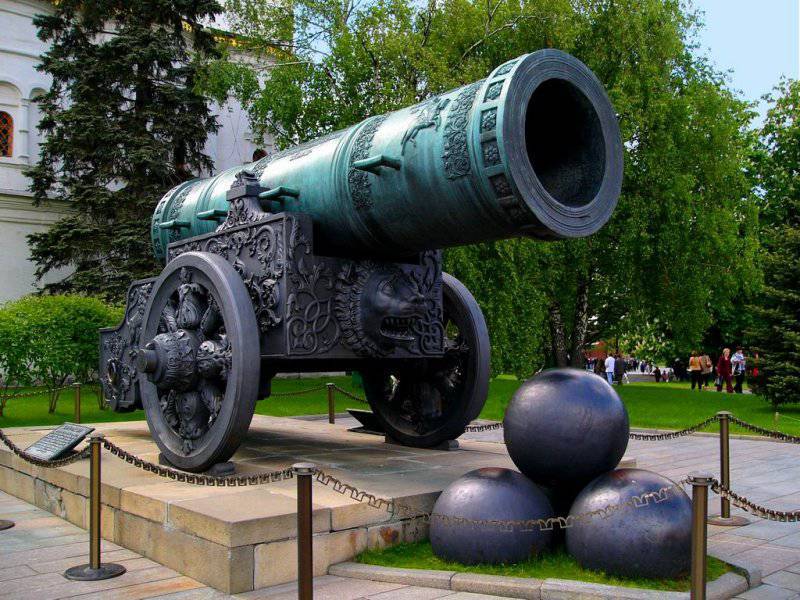
Heroes of the Trojan War on the old guns
Trojan guns, which depict heroes of the Trojan War, namely, the kings of supposedly ancient Troy, deserve special attention. Very interesting is their story. Here, for example, one of them, also made by Chokhov under the name “Troil”. Troilus was the name of the son of the oldest Trojan king Priam. On the bronze barrel of the cannon it is written “by the grace of God and the command of the sovereign tsar and grand duke Fyodor Ioannovich of All Russia this squeal“ TROIL ”of summer 7098 was made. Did Andrei Chokhov.
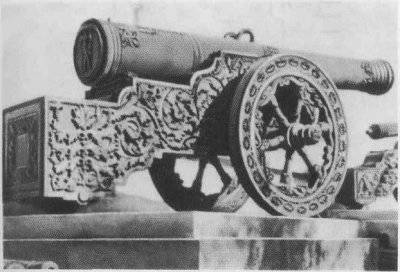
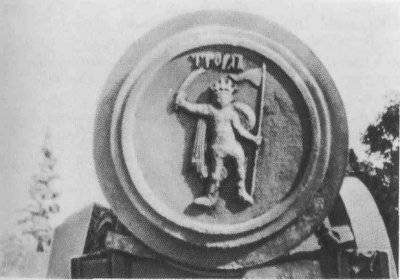
In the center of the trunk of the torrels – the turrets of the Trojan king with a banner and a sword. The “Troil” weighs seven tons with a barrel length of 4,5 meter and a caliber of almost 10 inches. And there are several such cannons with antique Trojan heroes in Moscow. There is one more “Troil”, but copper and cast in 1685 by cannon master Jacob Dubina. Already, naturally, by the order and divine grace of the kings Peter and Ivan Alekseevich. On the gun barrel there are also images of kings seated on a throne. Weighing in 6,5 tons has a barrel length 3, 5 meters and caliber 7, 5 inches.
But not all surviving weapons depict Trojan heroes. For example, on the well-known Tsar Cannon on the trunk is shown a galloping horseman, it is implied that this is Fedor Ivanovich, that is, the king, but only Russian, and not the Trojan and the oldest.
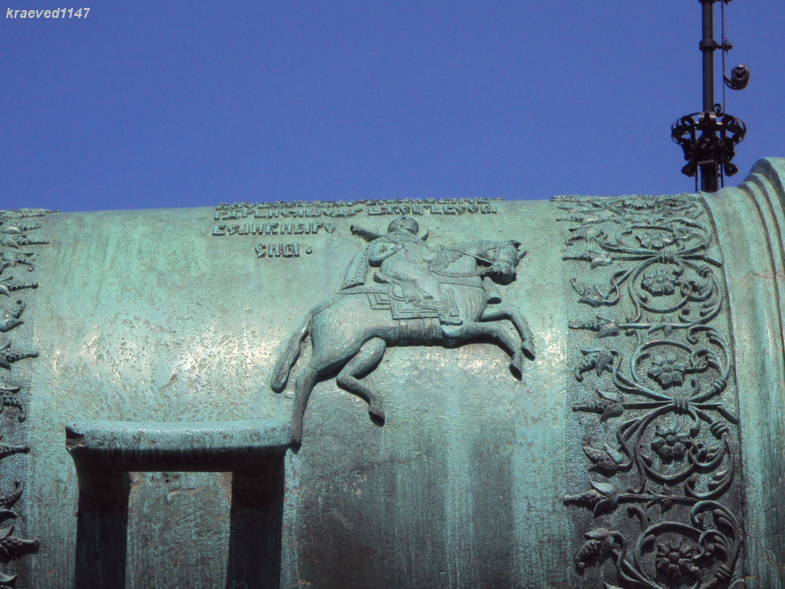
Do not you think that based on the traditional Romanov history, this is somehow strange? On some instruments cast at the same time they depict Russians, and on other Trojan kings. After all, the distance between them, according to Skaleger, is three thousand years.
In St. Petersburg, there is a bombardment “Achilles”, cast in the XVI century. And again, like a Russian gun, and the name of the ancient. Of course, this can be explained by a passion for everything Trojan, a certain fashion then, although history tells us nothing about it. But here’s the catch, Gnedich translated the Iliad Homer into Russian only in the 20-ies of the XIX century, in Europe itself the Iliad was not known during the Middle Ages. The question is different, what could be such a fashion, when even the translation did not exist.
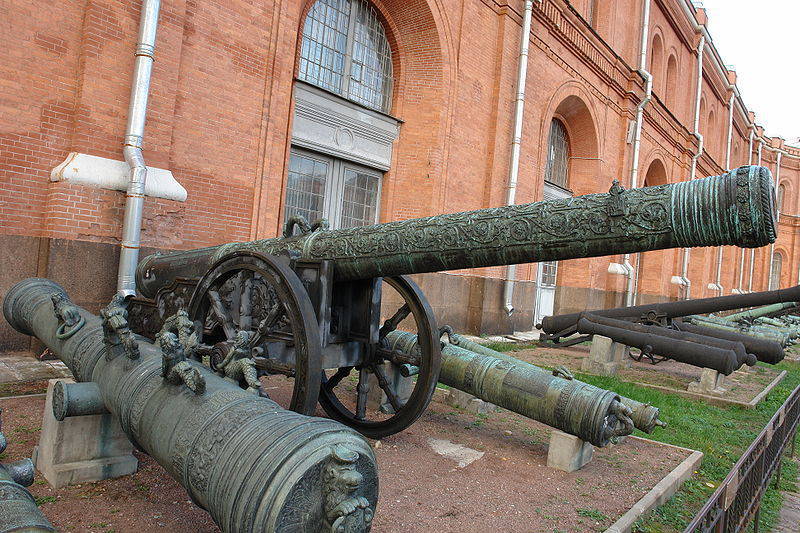
And these are only three Trojan horses, although they can also be called the Tsar – cannons, since the kings are depicted on them, how many of them were cast is not known. But the history of Trojan turrets is fine, but what about the Turkish ones, that is, those depicted, according to traditional history, non-Christians – the eternal enemies of Russians and all Christians. For example, the mortar “New Persian” on it depicts a man in a turban, presumably by the name of the gun Persian. It was signed on the breech of the gun, as well as on the second Troilus, that by sovereigns and grand princes and so on and so forth … John and Peter Alekseevich cast in the city of Moscow in 7194, that is in 1686 year. It is called “New Persian”, by the way, judging by the name, since this is a new Persian, it means that there was an old one. It turns out that the cannon has some kind of history and there used to be some other cannon, just the “Pers”, after whom they named this one.
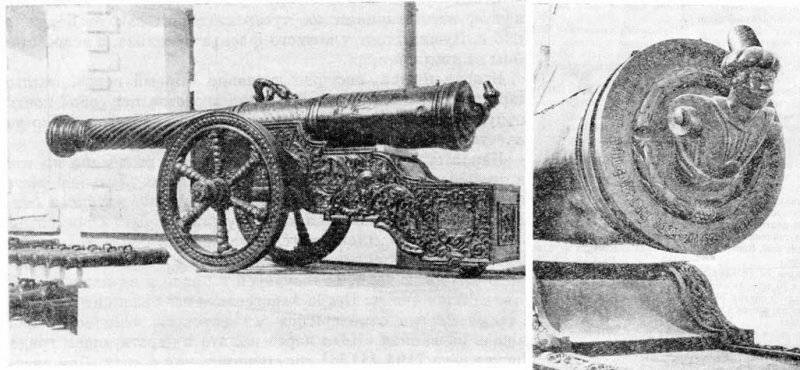
In general, it is extremely difficult to explain all this from the point of view of traditional history. Probably the Russians and the Ottomans were not such enemies, perhaps they were even allies. And in Istanbul, it was not the enemy who ruled, but the friend and ally of the Russian tsar, the Ottoman sultan. From that and the image on the old guns, as the Russian and Ataman troops fought side by side, and not with each other. And there were these troops of two parts of the once united Mongolian, that is, the Great Empire. And even with the first Romanovs, they still remembered and knew about it, therefore they continued to make cannons with common old images. And with regards to the Trojan kings, they are not the kings of some legendary Troy, who allegedly lived several millennia before, but the real medieval Troy, the capital of the empire, also known as Istanbul-Constantinople. And not the Persians, the current Persians are meant by the name of the gun, and our Russian Cossacks. Since it is known for certain that the Cossacks wore a turban. Yes, and Persia is only a slightly modified word Prussia, that is, In Russian, the words are the same without a vow.
The biggest Tsar Cannons in the world
According to the history of the cannons, the presence of such gigantic guns among the Russians indicates their leading role in artillery matters, as well as the exceptional position of the Russian army at that time. No one in Europe then possessed such artillery. And the Tsar Cannon, which has come down to our day, was at that time one of the world’s largest cannons, but not the only one. And, in particular, about the fact that they never shot from it and it is impossible to shoot something.
By its type of shooting, the Tsar-cannon is a mortar, and from the XVI century it is the only instance that has come down to us, but already in the XVII-XVIII analogues existed and were very successfully used. In general, many bombardments were made in Moscow before Chokhovoy, the author of the Tsar Cannon known today. In 1488, Pavel Debossis, also weapons master, cast a mortar, which was also called the Tsar Cannon. In 1554, a mortar was cast from cast iron, which weighed 1,2 tons and had a caliber of 650 mm, the next year another one of approximately the same characteristics.
This is evidenced by the stories and sketches of foreign ambassadors and travelers. As well as the schemes of the Kremlin of the XVI century, which shows the location of the guns at all the gates of the Kremlin. But these tools did not live to see us. So various mortars and howitzers in the Russian army of that time were enough. And by the way, the Tsar Cannon was supposed to shoot not the cores, but the canister. And those cores that are standing next to her just a sham, hollow inside. The Tsar Cannon itself has another name “Russian Shotgun”, as it was made for shooting with a piece of paper. And although she did not take part in the hostilities, she was cast as a battle tool, and not a sham of the king’s whim to satisfy her vanity. It seems strange to spend so much power and metal to create just a toy, it was not so loose then with the cast iron. In the history of the Soviet time, monuments were cast from cast iron to all those who are not lazy, and then they were still satisfied, calling bombers after someone and their images on the trunks.
Andrei Chokhov himself cast a lot of guns. And these guns have distinguished themselves in the history of many campaigns of the then kings. And all his guns were distinguished by their enormous size, excellent finish and generally excellent quality of work. So, in 1588 Mr. Chokhov, the author of Tsar-cannon, he cast a stem gun from copper, a sort of multi-rod, in which each barrel had a caliber of 50 mm. This cannon of a hundred cannons was considered a miracle of cannon art at that time. And in its superior tsar-cannon. Also about the size of the old cannons in Moscow can be judged by their cores, which were found a century ago in the old moat. Their dimensions were colossal to 70 cm in diameter.
So, Tsar Cannon, which stands today in the Kremlin, albeit a huge mortar. But there were also other large mortars, with which the Russian army was armed in the 16th century. From the report of Juan Persian (so called, it should be understood because of his stay in Russia, and not in Iran – Persia) to King Philip III that there are such huge cannons on Red Square that two people enter and clean it. Austrian secretary Georg Tektander writes about these cannons in his history, in particular, about two huge tools in which people can easily fit. Samuil Maskevich (a Pole, so called, presumably, also because of his stay in Moscow) says that there is a hundred-ringing food in China-City, which is charged with a hundred cores with a goose egg. She stood on the bridge at the Frolov gate, looking towards Zamoskvorechye. And he saw a cannon in Red Square, in which three people played cards.
Near the Kremlin stood two cannons, which can rightly be called the king-cannons. One Kashpirov, made it in 1554, the teacher Chokhov Kashpir Ganusov. Its weight was 20 tons with a length of 5 meters. The second Peacock, which Stepan Petrov cast in 1555, its weight was 16 tons. The vents of both of these guns looked in the direction of Zamoskvorechye. As you understand, in the event of an attack on the Kremlin, the enemies would not have been good, for with their colossal size they could cover huge areas with canister, and although this did not happen in history, the possibility itself is already terrifying.
In Nuremberg in the German National Museum, you can see the exhibition of ancient cannons. The largest of them has a thin inner metal trunk, which is located inside a thick log, which, in turn, is covered for durability outside with iron hoops. This lightweight technology for the production of guns allows you to quickly maneuver and transport weapons in the campaign. Such lungs, and as they are called, wooden guns, according to history, were used earlier in service in the Russian army, they were called peelers.
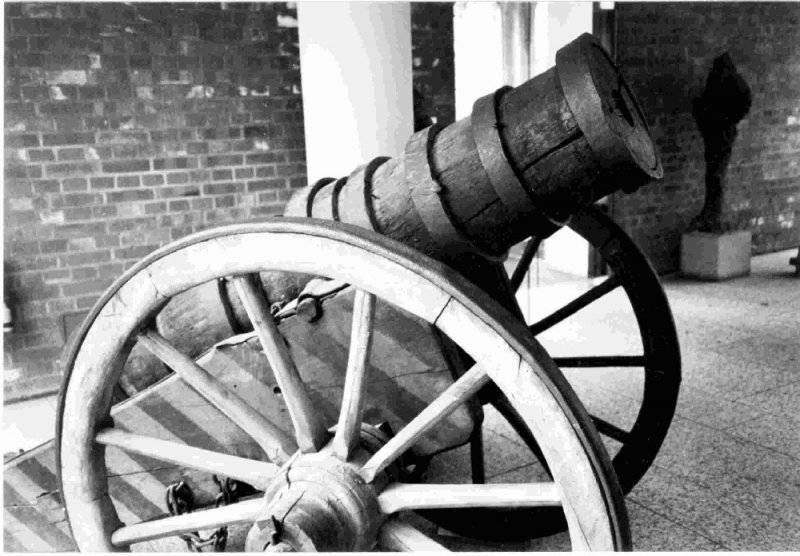
Today it is difficult to restore the real history of the Tsar – guns in Russia before the XVII century. The same thing with the history of pre-Petrine Russian fleet, as they want to convince us that before him in Russia and the fleet was not there. The troubles of the beginning of the XVII century and the coming to power of the Romanovs turned a lot upside down. Most of the cannons and bells were melted, or even simply buried, maybe now they are somewhere. But nevertheless there were so many guns that in spite of all the vicissitudes of history something came to us that allows us to judge the power and indestructible strength of the Russian army of the XNUMXth-XNUMXth centuries.